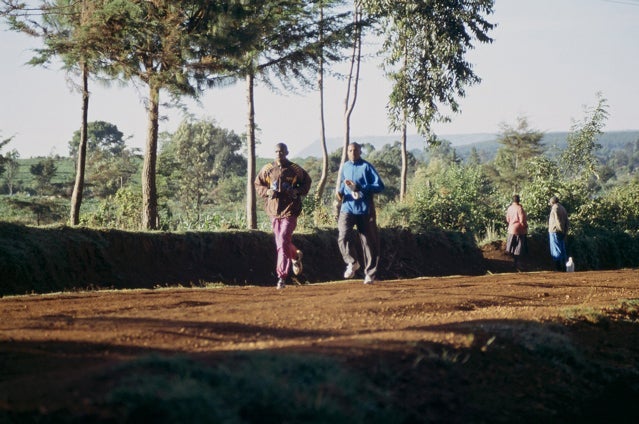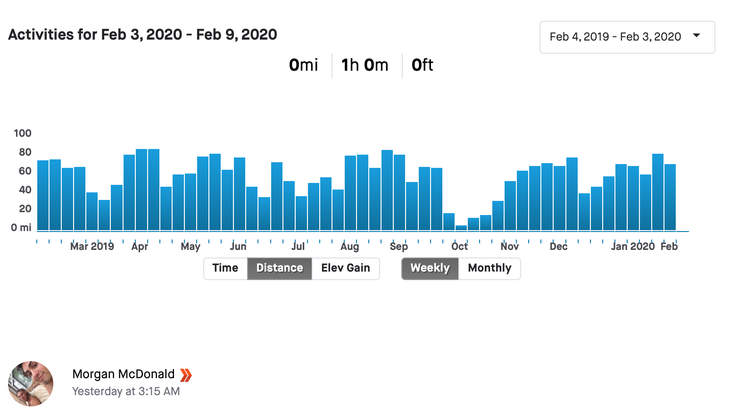In Maine, where I grew up, the old-timers have an expression about this time of year: “Days are gettin’ longah, wintahs gettin’ strongah.” That’s certainly true this week where I’m writing from Boulder, Colorado, as it is across much of the country.
February and March are hard months to be a runner. As much as we enjoy getting out in the cold and snow, it is undoubtedly more difficult—from the layers of clothing we need to wear to the dangers of slipping on sketchy surfaces underfoot.
In the face of wildly variable weather and logistical challenges, we need to make the daily decision to get out less difficult, and make the running itself easier. One way to do this, perhaps counterintuitively, is to train more like elites. This involves having more variety in our running pace—faster some days, slower on most—and less variety in our training consistency.
Faster and Slower
Why will going faster make running easier? Because speed gives us smoother, more efficient strides, keeps us mobile and healthy, and is just plain fun—especially the “camouflaged speed work” we can do all year: short, fast bursts, charging up hills and cruising at a fast-but-fun pace. Speed keeps us from getting in ruts—in our stride and in our routines. And, knowing we’re going to do some intensity today makes the run feel more important, makes us less likely to skip it than if it were just another run.
On the flip side, we can make running easier by going slower on most days. You’ve heard it before: Elite runners who can race marathons at a pace faster than we can run 200 meters often do their easy runs as slow as we do, sometimes slower. Somehow many of us have fallen into a rut of going as fast as we’re able every single day, either by habit or proving our fitness to ourselves or others. Slowing down lets us cruise along without stress or struggle, finish the run feeling sorry that it is ending and looking forward to the next day, be it another enjoyable easy day or a fun, fast workout that we’re rested and ready for.

Most Days, But Don’t Stress Every Day
While having more variety in our pace can make running easier and more fun, the opposite is true with our frequency and volume. Among the many reasons why it is easier to run most days rather than just some days is that we remove “if” from the equation. When running becomes a bonafide habit, the question becomes simply “when”—when do I get to run today?
That said, for many of us, sometimes the answer to “when do I get to run today” is “never.” Jeff Gaudette, founder and head coach at Runner’s Connect, says he sees two primary reasons amateur runners are less consistent than pros: “One: Amateurs have a lot of outside factors that limit their ability to get in the miles, such as work, family. Two: They also have less time to spend on recovery and doing the little things, so they may need to back off volume more frequently to stay healthy.”
These realities can’t be avoided, so, when you have to take a day off, or settle for a lower-mileage week, give yourself a break and accept it. A healthy flexibility can make running easier, as well as make you a better runner. Obsessing over volume can sometimes be as detrimental as not getting it in.
Flexibility, a Formula for Success
Richard Lovett, coach of Team Red Lizard in Portland, Oregon, says, “I’ve known mid-level runners who were absolutely obsessive about getting their weekly volume—but that’s beginner thinking.” In contrast, he’s coached “one of the most consistently good non-pro runners in the Northwest” who is more mellow about her mileage.
“Part of her success is that she doesn’t try to force the training volumes, and my observation is that at the advanced, but non-pro level, that’s a formula for success,” Lovett says. “She lets it vary as the needs for taper, recovery, and ‘life’ dictate. If she’s feeling dinged, she simply takes an unscheduled day off. If weather throws her a curve—like 10 days of snow, while vising her family, in snow country—she just rolls with the punches. When the snow melts, or she gets back to dryer terrain, she’ll come back hard.”
Note, however, that her inconsistency still looks like a lot of quality weeks to most of us. Lovett lists a string of her weekly miles: “59, 56, 42, 33, 57, 65, 38, 59, 39, 0, 57, 60, 57, 71, 77, 75, 70, 82, 53, 80, 80…” Yes, she’ll drop in a 33-mile week, or even a zero, but those are the exceptions: Most weeks she’s averaging high 50s to 80 miles per week. And those consistent miles make it easier to do the next strong week, as well as to have the confidence not to fret when life intervenes. Skipping one meal won’t make anyone who normally gets three a day starve or waste away.
Even professional runner Morgan McDonald, who won NCAA national titles in cross country and the indoor and outdoor 5,000m last year, told me at the Under Armour Human Performance Summit, “You can look at my Strava, and it’s not as pretty as you may think. I’ll take time off if I have little niggles or injuries, and I’ll cross train for a bit. I look at people who run every single day, and sometimes I’m like, ‘I wish I could do that.’ But I don’t need to.”

Again, McDonald’s idea of inconsistency is a lot more miles than many of us ever log. “I’m confident if I can clock off 75–80 miles per week, I’ll be really good,” he says. “I know that if I can get close to that, I’ll still be really good.”
Whatever your weekly totals, the important thing is that your breaks are valleys in what is usually a steady ridge of days and weeks, rather than becoming part of a string of lowlands with mountains of hard weeks poking up here and there. That kind of inconsistency is a recipe both for making each run harder, and for injury—as your body lacks the habit and durability of daily miles.
I believe in consistency and I love running every day, even on days most would consider too nasty, like during yesterday morning’s sleet and snow. But when I woke this morning to 9 inches of snow over a bed of ice, I shoveled the driveway, did some lunges, squats and heel raises, and took the day off from running. I miss it, but I’m not feeling guilty. Neither should you. Tomorrow will be easier—and I may get to do some hill sprints.

—Jonathan Beverly, Editor


